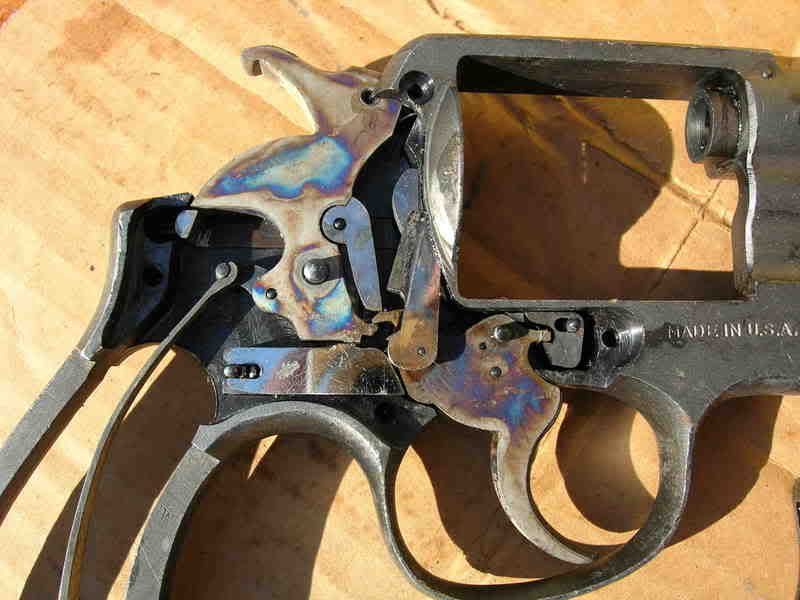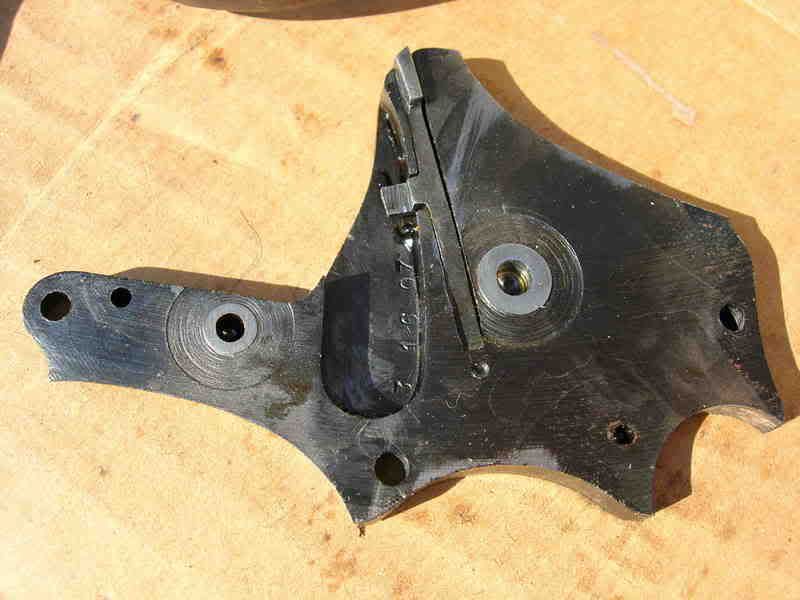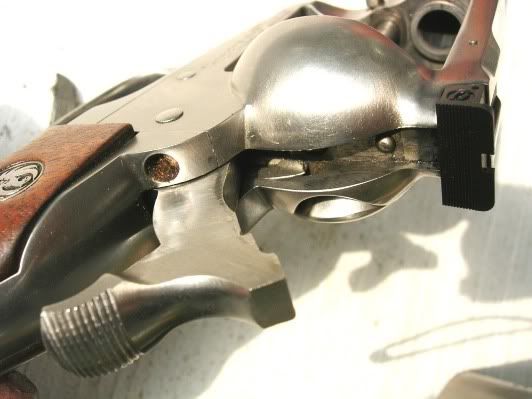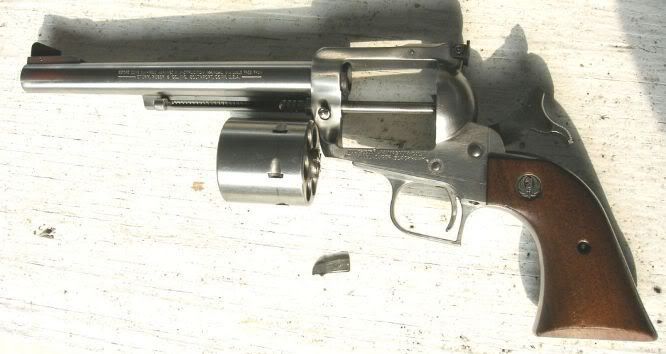
 |
|
|||||||
| Forum Rules | Firearms Safety | Firearms Photos | Links | Library | Lost Password | Email Changes |
| Register | FAQ | Calendar | Search | Today's Posts | Mark Forums Read |
 |
|
|
Thread Tools | Search this Thread |
|
|
#1 |
|
Junior Member
Join Date: September 23, 2011
Posts: 2
|
Colt Transfer-Bar Lockwork vs Hammer-Block Safety
I've been looking for a Colt Trooper MK-III or V within the next year.
But now, I've come across a 4" Colt Model 357 in very good shape for around $450. In reading, I've come to grasp most of the differences, & think that I'd probably be just as happy with the Model 357 for this cheaper price. EXCEPT that I have no idea of what the differences (between the Model 357's Hammer-Block Safety, and the MK-III & V's Transfer-Bar Lockwork system) mean in practical terms. From the little I've been able to find, they BOTH are supposed to keep the gun from firing unless the trigger is pulled; but a few places go on to say that the Transfer-Bar Lockwork is better, & was adopted by many other gun makers. The only hint I've found briefly mentioned that the transfer-bar system may be safer for carrying with all cylinders loaded. For me, this gun would only be for target/range/plinking. Could someone help me understand what the differences are in practical terms ? Thanks. |
|
|
|
|
#2 |
|
Senior Member
Join Date: May 4, 2001
Posts: 7,478
|
Both systems are about equally safe.
It's just that the transfer bar safety-ignition system is a lot cheaper to build because of the simplicity of the design. The older rebounding hammer block system has to be hand fitted, the transfer action is simply assembled with no fitting required. This lowers the price of the gun, which is why every DA revolver and many SA revolvers now use the design. It simply costs less, it's not necessarily better. So, there are no practical differences to the user, both designs are as safe as a revolver can be, and both are perfectly safe to carry fully loaded. In both designs, the only way to get the revolver to fire is to deliberately pull the trigger. The Colt 357 is a premium revolver, and is often known as a "poor mans Python" since it was the precursor to the Python, and is essentially the Python without the heavy ribbed and lugged barrel, brilliant blue job, and more tuned action. The Mark III is a very high grade gun, but the 357 is a more refined and collectible gun. The Mark III is a more durable gun and was designed from the get-go for unlimited use with full power .357 ammo with none of the >potential< problems of the older Colt action for getting out of time. (Colt's getting out of time is nothing near what the internet would have you believe). The choice comes down to which seems more to your liking. Both were the premium Colt of it's day, both will last more than a lifetime even with Magnum ammo. |
|
|
|
|
#3 |
|
Senior Member
Join Date: February 14, 1999
Location: Pittsburg, CA, USA
Posts: 7,417
|
Dfaris is right, in that all of the Colt hammer-block safeties of this era were very respectable.
A hammer-block safety puts a barrier up in front of the hammer to prevent it's complete fall. The barrier is pulled away when you pull the trigger - rendering the gun drop-safe. The transfer bar system doesn't block the hammer. Instead the hammer is shaped at the top so it can't hit the firing pin at all, ever. A piece of metal called the "transfer bar" rises between the hammer and firing pin when the trigger is pulled back, and this "transfers" the hammer's energy to the firing pin. If a hammer block sticks for some reason (gunks up?) or breaks off, the gun reverts to a no-safety state and will still fire. If a transfer bar breaks, the gun can't fire at all. If you had to in an emergency (wilderness survival?), you'd have to glue a piece of metal to the hammer's face to allow the gun to go boom. Technically the transfer bar is considered "safer" but as a practical matter a good hammer block will be fine. I would recommend with each cleaning the hammer-block's function be tested if you're concerned - see also "the checkout", stickied post, this sub-forum for checkout procedures. A hammer-block-based gun can have up to 25% less mainspring pressure and still go boom every time. The transfer bar eats some energy. So the trigger pull on a hammer block gun can be "nicer" than a transfer bar gun's trigger...by at least a bit. Now...you didn't exactly ask about this but...you should be aware of a few other things where DA Colts are concerned. Colt doesn't make 'em any more. OK? The classic ones with hammer blocks like the original 357 and the Python have tricky and somewhat delicate innards and can go out of time faster than other designs. The gunsmiths who know how to tweak them back together are either retiring or dying out  . .This is also an issue with the relatively newer Colt transfer-bar guns, but those are tougher. If you're dead set on a Colt DA that you can actually shoot and carry for hunting/defense/whatever, I would have to recommend the later era type. I think however you'd be better off with a Ruger GP100. Sorry, had to be said. If you're trying to buy for collector/investment purposes, and you didn't yet know the difference between a transfer bar and a hammer block...ummm...yeah, I gotta say it: you don't know enough to be trying to do guns as an investment. OK? Even the checkout will help only to a limited degree because it wasn't written to help collectors. It was written to help people buy a "shooter" - something that they actually intend to use. Buying collector-grade guns is a whole 'nuther subject with different criteria that varies with the era of gun involved. What constitutes "cherry" for an 1895 piece will be quite different from the same standard for something made in 1969.
__________________
Jim March |
|
|
|
|
#4 |
|
Member in memoriam
Join Date: April 26, 2002
Location: Colorado
Posts: 1,649
|
If I had a choice among a Colt 357, a Mark III Trooper, or a Mark V, all in shootable condition, I'd choose the 357. Yes, it's older, and yes, I'd bear in mind there's a small chance it would go out of time if I did a lot of double action shooting with hot ammunition, but it's more likely to have the kind of light, crisp single action trigger I like best, and certainly ought to be rugged enough to last my lifetime and another couple generations.
There's nothing wrong with Colt's later revolvers, and in fact, I'll always regret not keeping my better Mark III, but I've never found another revolver that comes close to the Officer's Model-357-Python family for simple old-fashioned excellence.
__________________
No tyrant should ever be allowed to die of natural causes. |
|
|
|
|
#5 |
|
Senior Member
Join Date: November 21, 2004
Location: Twangtown
Posts: 175
|
'menot,
You will absolutely prefer the action on that 357 to the trigger on the later Colts. I have, and shoot both, there is no adequate verbage to describe how superior the older lockwork feels. Mike |
|
|
|
|
#6 |
|
Senior Member
Join Date: November 25, 2008
Location: California
Posts: 1,951
|
I bought a New Trooper Mk III when they first came out S/N J2880, I regret ever selling it.
__________________
http://www.armsmaster.net-a.googlepages.com http://s239.photobucket.com/albums/f...aster270/Guns/ Retired LE, M.P., Sr. M.P. Investigator F.B.I. Trained Rangemaster/Firearms Instructor & Armorer, Presently Forensic Document Examiner for D.H.S. |
|
|
|
|
#7 | |
|
Senior Member
Join Date: July 20, 2005
Location: Indiana
Posts: 10,446
|
Quote:
|
|
|
|
|
|
#8 |
|
Senior Member
Join Date: February 14, 1999
Location: Pittsburg, CA, USA
Posts: 7,417
|
In case anybody googles this later, the hammer block safeties that I don't trust:
* Pre-WW2 S&W. At least not for street carry. * Freedom Arms '83 (large frame). Hammer down on an empty chamber. * Any Italian single action with a "quasi-hammer-block" thingie such as Uberti experimented with. Hammer down on an empty chamber. The only safe-fully-loaded Italian transfer-bar single actions that I know of are the Beretta-branded variants and the Heritage Big Bore which is a re-branded Pietta with stateside finish and assembly. I would also be damned skeptical of any Taurus that has an importer's mark - in other words, made before Taurus had a stateside corporate presence in Florida. And stay WAY the hell away from any Spanish copy of an S&W or Colt, and anything from Argentina under the "Comanche" or similar brand name wheelguns. "Bad" doesn't even begin. Oh, and the EAA Windicator blows chunks  . Doesn't matter if any of these are transfer-bar or hammer-block based. They're diseased . Doesn't matter if any of these are transfer-bar or hammer-block based. They're diseased  . .
__________________
Jim March |
|
|
|
|
#9 | |
|
Senior Member
Join Date: May 27, 2007
Posts: 5,261
|
Quote:
  I don’t have pictures of modern S&W lockworks, but I like the hammer block safeties of the post WWII S&W’s. However modern design philosophies have taken a “fail safe” approach. That is when the mechanism fails, it fails safe. That can be very good, or very bad, depending on the situation. The hammer blocks safeties of S&W’s if they break, the gun can still be fired if the broken piece has not gummed up the mechanism. I like that. Transfer mechanisms, like the one on my Ruger, when it broke, there was no way at all to fire the mechanism. I did not like that. I like “battle shorts” in my extreme danger mechanisms. There are so many mechanisms around now that fail inoperative and when they go, it can be extremely frustrating to say the least.  
__________________
If I'm not shooting, I'm reloading. |
|
|
|
|
|
#10 | |
|
Senior Member
Join Date: February 14, 1999
Location: Pittsburg, CA, USA
Posts: 7,417
|
Quote:
Only thing is, you have to file the hammer down a bit where it hits the transfer bar. The other thing about Ruger SA transfer bars breaking is, we THINK it's related to the "transfer bar pinch" problem that sometimes happens. If you dry-fire it unloaded, keep holding the trigger back, push the hammer forward and then let up on the trigger, the trigger is supposed to go forward. If it doesn't, it's because the hammer is "pinching" the transfer bar, putting more stress on it than necessary. If you fit a mid-frame transfer bar to a large-frame gun, this is what will happen. Ditto fitting a large-frame hammer to a mid-frame gun. Either way, or in any case where it's pinching, the solution is to cock it (unloaded!), wrap a rag around the hammer's base to keep the grit out and file on the part of the hammer that would hit the transfer bar. Do this in stages, check for pinch ever 10 strokes or so, get it to where the pinch just barely stops. Something to do while watching TV or the like  . .
__________________
Jim March |
|
|
|
|
|
#11 |
|
Senior Member
Join Date: October 22, 2010
Posts: 499
|
The 357 will be just as safe as a Trooper MKIII or MKV, but it will have a much better trigger. I carry a 4" Trooper .357 (not MKIII or MKV) which is the same gun as the 357 with a lower level of finish.
|
|
|
 |
| Tags |
| colt , hammer , lock , safety , trigger |
| Thread Tools | Search this Thread |
|
|